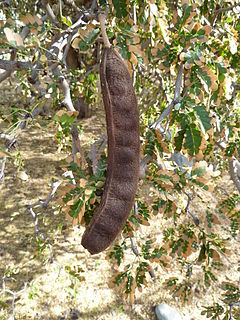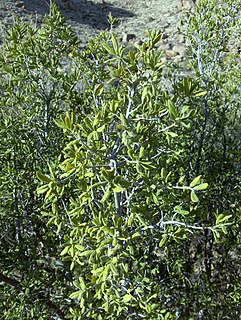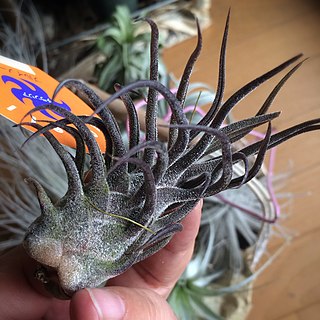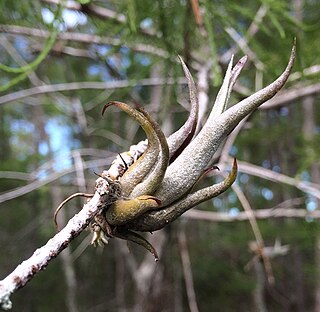
Spanish moss is an epiphytic flowering plant that often grows upon large trees in tropical and subtropical climates. It is native to much of Mexico, Bermuda, the Bahamas, Central America, South America, the Southern United States, West Indies. It has been naturalized in Queensland (Australia). It is known as "grandpas beard" in French Polynesia.

Tillandsia is a genus of around 650 species of evergreen, perennial flowering plants in the family Bromeliaceae, native to the forests, mountains and deserts of northern Mexico and south-eastern United States, Mesoamerica and the Caribbean to mid Argentina. Their leaves, more or less silvery in color, are covered with specialized cells (trichomes) capable of rapidly absorbing water that gathers on them.

Nolina is a genus of tropical xerophytic flowering plants, with the principal distribution being in Mexico and extending into the southern United States. They are large, dioecious plants.

Tillandsia recurvata, commonly known as small ballmoss or ball moss, is a flowering plant in the family Bromeliaceae that grows upon larger host plants. It grows well in areas with low light, little airflow, and high humidity, which is commonly provided by southern shade trees, often the southern live oak. It is not a parasite like mistletoe, but an epiphyte like its relative Spanish moss.

Echinocereus reichenbachii is a perennial plant and shrub in the cactus family. The species is native to the Chihuahuan Desert and parts of northern Mexico and the southern United States, where they grow at elevations up to 1,500 meters (4,900 ft). This cactus earned the Royal Horticultural Society's Award of Garden Merit.

Tillandsia bartramii, commonly known as Bartram's airplant, is a species of flowering plant in the bromeliad family. It is native to Florida, South Carolina and southern Georgia in the United States as well as Guatemala and Mexico. The name honours William Bartram, an early Florida naturalist.

Tillandsia caput-medusae is a species of flowering plant in the bromeliad family, Bromeliaceae, subfamily Tillandsioideae. Common names include octopus plant and medusa's head. An epiphyte native to Central America and Mexico, T. caput-medusae is a commonly cultivated bromeliad species. The thick, channeled, tapering and twisting leaves are up to 25 cm (9.8 in) long and are covered in fine gray hairs. The rosette of leaves arise from an inflated pseudobulb. Pups are produced after blooming, as is usual with most Tillandsia species.

Ebenopsis ebano is a species of flowering plant in the pea family, Fabaceae, that is native to the coastal plain of southern Texas in the United States and eastern Mexico. It is commonly known as Texas ebony or ebano.

Tillandsia intermedia is a species in the genus Tillandsia. The species is endemic to western Mexico, reported from Guerrero, Sinaloa, and Jalisco.

Diospyros texana is a species of persimmon that is native to central, south and west Texas and southwest Oklahoma in the United States, and eastern Chihuahua, Coahuila, Nuevo León, and Tamaulipas in northeastern Mexico. Common names include Texas persimmon, Mexican persimmon and the more ambiguous "black persimmon". It is known in Spanish as chapote, chapote manzano, or chapote prieto, all of which are derived from the Nahuatl word tzapotl. That word also refers to several other fruit-bearing trees.

Tillandsia pruinosa, is a species of flowering plant in the Bromeliaceae family. It is commonly known as the fuzzywuzzy airplant. This species is native to northern South America, Central America, southern Mexico, the West Indies and Florida.

Tillandsia fasciculata, commonly known as the giant airplant or cardinal airplant, is a species of bromeliad that is native to Central America, Mexico, the West Indies, northern South America, and the southeastern United States. Within the United States, this airplant is at risk of extirpation from the Mexican bromeliad weevil, Metamasius callizona.
Tillandsia festucoides, commonly known as the fescue airplant, is a species of bromeliad that is native to the Greater Antilles, Mexico, the Cayman Islands, and Central America.
Tillandsia flexuosa, the twisted airplant, is a species of bromeliad in the genus Tillandsia. This species is native to Central America, southeastern Mexico, northern South America and the United States (Florida).

Tillandsia paucifolia, the potbelly airplant, is a species of bromeliad in the genus Tillandsia. This species is native to Central America, central and southern Mexico, Venezuela, Colombia, the West Indies, and Florida.

Tillandsia utriculata, commonly known as the spreading airplant or the giant airplant, is a species of bromeliad that is native to Florida and Georgia in the United States, the Caribbean, southern and eastern Mexico, Central America, and Venezuela.
Tillandsia variabilis, the leatherleaf airplant, is a species of bromeliad in the genus Tillandsia. This species is native to Bolivia, Costa Rica, Mexico, Venezuela, Colombia, the West Indies and southern Florida.

Agave virginica, synonym Manfreda virginica, commonly known as the false aloe, rattlesnake master, American aloe, and Virginia agave, is a species of agave. It is native to an area stretching from North Carolina west to Texas in the United States and south to Nuevo León and Tamaulipas in Mexico.

Vernon Orlando Bailey (1864–1942) was an American naturalist who specialized in mammalogy. He was employed by the Bureau of Biological Survey, United States Department of Agriculture (USDA). His contributions to the Bureau of Biological Survey numbered roughly 13,000 specimens including many new species. Bailey published 244 monographs and articles during his career with the USDA, and is best known for his biological surveys of Texas, New Mexico, North Dakota, and Oregon.
Lorandersonia baileyi, is a North American species of flowering plants in the aster tribe within the sunflower family. It was initially discovered in the Guadalupe Mountains of New Mexico in 1902, and has since been collected in Arizona, Utah, Colorado, Kansas, Oklahoma, Texas, Chihuahua, Coahuila, and Nuevo León.















